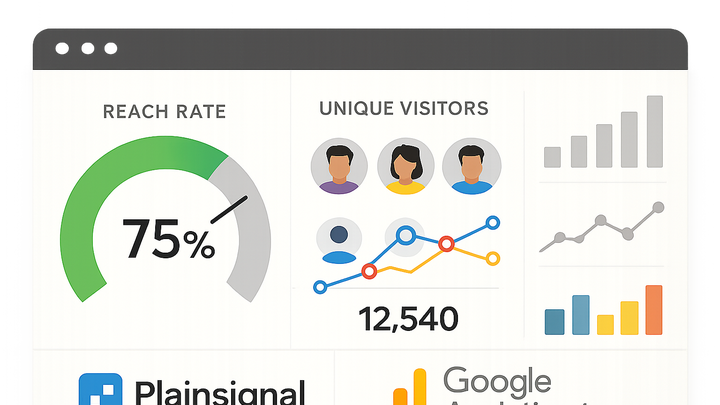Published on 2025-06-26T05:22:36Z
What is Reach Rate? Examples of Reach Rate in Analytics
Reach Rate is a metric in analytics that measures the percentage of unique users who have been exposed to content or campaigns within a defined time period. It helps marketers assess how broadly their message is disseminated across their target audience, distinguishing between mere impressions and distinct reach. A higher reach rate indicates wider audience coverage, while a lower rate may signal oversaturation among a small group or ineffective targeting. By understanding reach rate, organizations can optimize media spend, refine targeting strategies, and balance reach with frequency to maximize campaign effectiveness. Commonly used across digital marketing platforms like PlainSignal and Google Analytics 4, reach rate offers insights into audience penetration beyond standard engagement metrics.
Reach rate
Reach Rate is the percentage of a target audience reached by unique users, indicating campaign coverage efficiency.
Why Reach Rate Matters
Reach Rate serves as a key performance indicator for understanding how effectively campaigns expose content to new users. Unlike impressions, which can count multiple exposures to the same individual, reach rate focuses solely on distinct audience members. This distinction helps marketers gauge brand awareness, optimize budget allocation, and prevent ad fatigue by monitoring unique user exposure.
-
Indicator of campaign effectiveness
A high reach rate suggests strong visibility among the intended audience, reflecting successful targeting and content distribution.
-
Balancing reach and frequency
By tracking reach rate alongside frequency, marketers can ensure they reach enough unique users without overexposing the same individuals to repetitive messaging.
Calculating Reach Rate
The formula for reach rate is straightforward, enabling teams to compute and compare performance across campaigns and channels. Clear definitions of numerator and denominator are essential for consistency and accurate benchmarking.
-
Basic formula
Reach Rate = (Unique Users Reached / Total Target Audience) × 100
-
Unique users reached
The count of distinct individuals who have encountered your content at least once during the measurement period.
-
Total target audience
The estimated pool of potential viewers defined by your campaign parameters or market research.
-
-
Example calculation
If 1,500 unique users saw your ad out of a target audience of 10,000, then Reach Rate = (1,500 / 10,000) × 100 = 15%.
Tracking Reach Rate with Analytics Tools
Reach Rate can be implemented and monitored using analytics platforms like PlainSignal and Google Analytics 4. Each tool provides its own approach to tracking unique user exposures and deriving reach metrics.
-
PlainSignal (cookie-free simple analytics)
PlainSignal offers a privacy-focused, cookie-free solution that tracks unique visits and calculates reach rate in its dashboard. To set up PlainSignal, include the following snippet on your site:
-
PlainSignal tracking code
<link rel="preconnect" href="//eu.plainsignal.com/" crossorigin /> <script defer data-do="yourwebsitedomain.com" data-id="0GQV1xmtzQQ" data-api="//eu.plainsignal.com" src="//cdn.plainsignal.com/plainsignal-min.js"></script>
-
-
Google analytics 4 (GA4)
While GA4 does not directly label a metric as “Reach Rate,” you can approximate it by dividing the number of first-time events or unique users by the total potential audience. Implement GA4 tracking with:
-
GA4 gtag.js implementation
<!-- Global site tag (gtag.js) - Google Analytics --> <script async src="https://www.googletagmanager.com/gtag/js?id=GA_MEASUREMENT_ID"></script> <script> window.dataLayer = window.dataLayer || []; function gtag(){dataLayer.push(arguments);} gtag('js', new Date()); gtag('config', 'GA_MEASUREMENT_ID'); </script>
-
